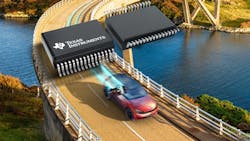Gate Driver Adjusts Current in Real-Time to Boost EV Range
This article is part of the TechXchange: Silicon Carbide (SiC).
At the heart of every electric vehicle (EV) is a traction inverter that converts direct current (dc) from the high-voltage battery into alternating current (ac) that powers the electric motor and turns the EV’s wheels.
This system’s efficiency has a direct impact on the maximum range of the EV per charge. But it’s difficult for engineers to gain even more efficiency, given that most traction inverters on the road already operate at over 90%. Many automakers are turning to a new class of power devices based on silicon carbide (SiC), as they can safely handle the high voltages and high operating frequencies of EVs with minimal losses.
A new gate driver with reinforced isolation and real-time variable output current from Texas Instruments aims to bring the best out of these power devices and enable automakers to increase EV range. While gate drivers are used to source and sink current at the gate of a FET to switch it on and off, TI said the UCC5880-Q1 can adjust its gate-drive current in real-time to minimize power losses.
The automotive-grade 20-A gate driver is configurable over the SPI bus and brings advanced monitoring and protection into the fold. The features help reduce design complexity and external component costs.
Supporting functional-safety ratings up to ASIL-D, TI said the isolated gate driver is designed to drive both SiC MOSFETs and IGBTs that are still widely used in the EV market.
Elevated Voltages
Most of the electric vehicles on the road qualify as complex, high-voltage power systems, as they operate with 400-V bus voltages. Further in the future, 800-V systems are set to become the standard for these vehicles.
Increasing the operating voltage of the EV cuts the current flowing through the wiring harness, which automakers can then shrink down. The minimized wiring harness reduces the weight of the system and, in turn, improves the EV’s overall range per charge. These higher voltages also facilitate faster charging times while reducing losses due to resistance heating, which helps take a load off the EV’s cooling systems.
Belonging to a class of wide-bandgap semiconductors, SiC can manage these high voltages safely, reliably, and more efficiently than IGBTs when used to convert and/or distribute energy around the EV. Specifically, SiC devices can handle 10X higher breakdown voltages, which reduces the resistance (RDS(on)) between the drain and source regions of the MOSFET when it’s turned on. Consequently, conduction losses are kept in check.
With the relatively wide bandgap of silicon carbide, less current also leaks out when the MOSFET is turned off. These characteristics give SiC better energy efficiency when used in EV traction inverters that pump out tens of thousands of watts.
Power devices based on SiC can also tolerate severe heat that can sap the performance of a system due to their higher junction temperature. The chips themselves are easy to cool relative to IGBTs, given their enhanced thermal conductivity. Reverse-recovery charge (Qrr) is reduced, too.
They’re also suited for operation at higher switching speeds, in large part because SiC supports 2X more electron saturation velocity than silicon. As a result, they can turn more of the energy stored in the battery into usable motor output.
Gate-Drive Carefully
But for all of its advantages, the unique physical and electrical properties of SiC power devices require you to control and drive them more carefully than IGBTs.
While SiC MOSFETs can switch at tens of kilohertz, they do so at very high transient voltages (dv/dt) of the drain-to-source voltage (Vds). Thus, they will still experience a degree of power loss when switching.
During switching, the MOSFET’s gate voltage (Vgs) is clamped to a region called the “Miller plateau,” where the voltage stays until sufficient charge has been added or removed to the input capacitors in the device to fully turn itself on. The more time the MOSFET (or IGBT) remains in between the on and off states, the more power is lost to switching transients and the more power wasted by the EV inverter.
The amount of current used to drive the gate in the device determines how long it takes to transition out of this region. If sufficient current is forced into the FET, the voltage rises to the point called the threshold voltage (Vth), where the device turns itself on. If the current is lacking, the switching losses will increase.
TI said the gate-driver IC in a power system must be able to supply maximum current when it hits this region to support fast slew rates. Doing so reduces deadtime and limits the power losses experienced by the FET when switching.
These fast transitions also lend themselves to fast-switching waveforms that are required to drive the electric motors at the heart of modern EVs. Such motors can operate at speeds greater than 20,000 RPM.
But these high switching speeds have pros and cons. The fast transitions can create voltage overshoot and electromagnetic interference (EMI) in the form of conducted ground currents. These currents may cause the controller in the EV’s traction inverter to malfunction. And given the potential for short circuits in the capacitance between the windings, the motor itself can also suffer from high dv/dt.
Programmable Current
But choosing a gate driver that can adjust its source and sink current to handle different switching speeds under varying conditions—including temperature, load, and voltage—can go a long way, according to TI.
By varying the gate-drive strength in steps from 20 A and 5 A in real-time, the company said UCC5880-Q1 can extract up to 2% more efficiency by reducing switching power losses from SiC devices. On average, this yields up to seven more miles of range per charge, the company said.
The dual-output gate driver can adapt output currents from ±15 to ±5 A, and it’s possible to program the current with or without SPI. Split-output gate drivers like the UCC5880-Q1 have separate turn-on and turn-off paths, giving them more control over the source and sink current.
Fast transitions are the preference when turning on a power FET to minimize power losses. TI said it makes more sense to reduce speeds when switching the device off to prevent it from turning on inadvertently due to voltage overshoot.
The gate driver has a wide input voltage (VCC) range of 3 to 5.5 V, while output voltages span 12 to 30 V.
The high-voltage transients of SiC MOSFETs can also induce current—called Miller current—inside the device through parasitic capacitance. Unless it’s diverted, the current may unintentionally turn on the device, resulting in unnecessary power dissipation.
The company said the gate-driver IC integrates a 4-A active Miller clamp to redirect the excess current without taking a toll on efficiency. The clamp serves to prevent the FET from turning on inadvertently by connecting the gate to ground (or negative voltage rail). Integrating the clamp also saves space in the power supply. The device supports active gate pull-down while the driver is unpowered.
Alternatively, it can be attached to an external Miller clamp, which can be placed closer to the FET in cases where it’s necessary to further reduce the impedance in the gate driver’s path. The higher the impedance, the worse it is at redirecting current.
To prevent high voltages from traveling where they’re unwanted or can expose humans to electric shock, the gate driver features reinforced isolation, with a planned withstand voltage rating of 5 kV RMS and transient isolation of up to 7 kV.
Powers of Protection
The UCC5880-Q1 comes with a wide range of power-transistor protections, including active short circuits on the primary and secondary sides. Overcurrent protection is supported by a shunt resistor in the system.
As power losses generate heat inside the FET, the gate driver adds overtemperature protection to help prevent damage over time (or total destruction). The part's operating temperature range is −40 to 125°C.
Internal and external supply undervoltage and overvoltage protection are also part of the package. The gate driver adds integrated diagnostics to help support up to ASIL D functional safety at the system level.
The 10-bit ADC inside the IC monitors up to dual analog inputs. It can measure voltages inside the gate driver and the temperature of the power FET and gate driver itself for enhanced system management.
According to TI, the protection, diagnostics, and other features are configurable over the 4-MHz SPI bus. Consequently, the new gate-driver IC can be paired with virtually any SiC MOSFET or IGBT on the market.
The automotive-grade gate driver also comes with common-mode transient immunity (CMTI) of 100 kV/µs.
Pre-production quantities of the new isolated gate driver are now available. The part comes housed in a 10.5- × 7.5-mm, 32-pin, shrink small-outline package (SSOP). Prices start at $5.90 for 1,000-unit orders.
Read more articles in the TechXchange: Silicon Carbide (SiC).
About the Author
James Morra
Senior Editor
James Morra is the senior editor for Electronic Design, covering the semiconductor industry and new technology trends, with a focus on power electronics and power management. He also reports on the business behind electrical engineering, including the electronics supply chain. He joined Electronic Design in 2015 and is based in Chicago, Illinois.


